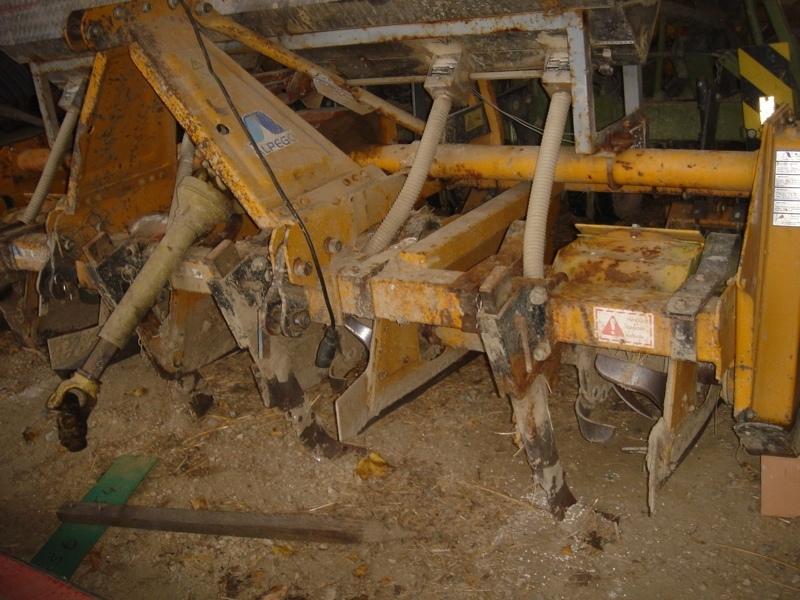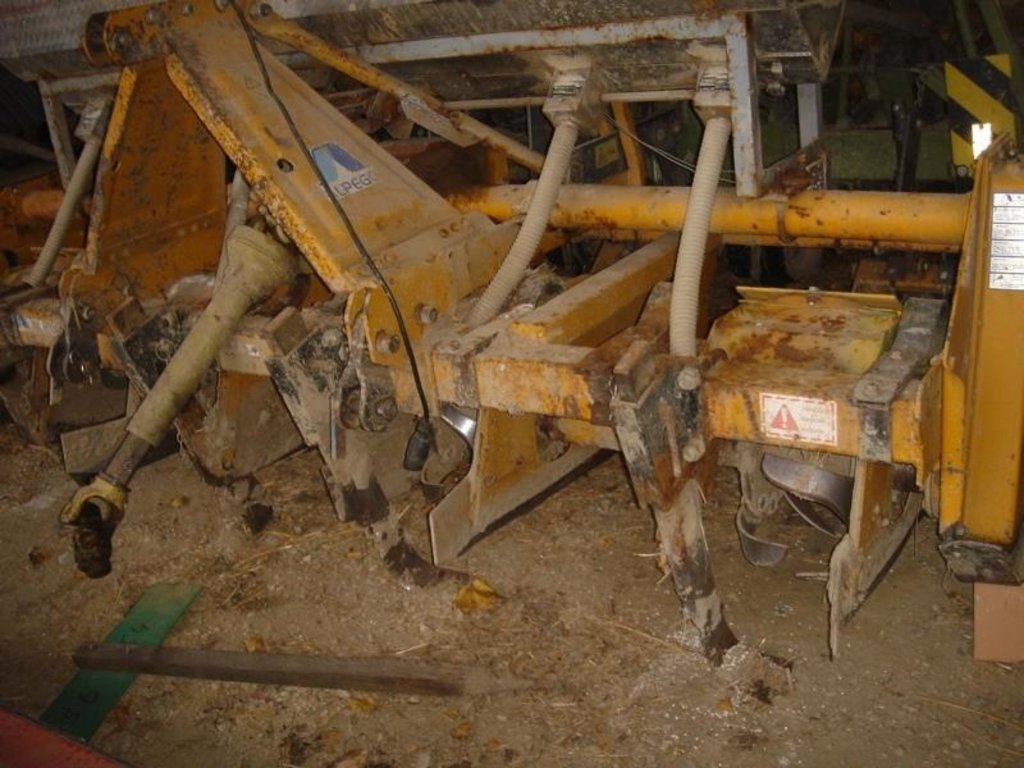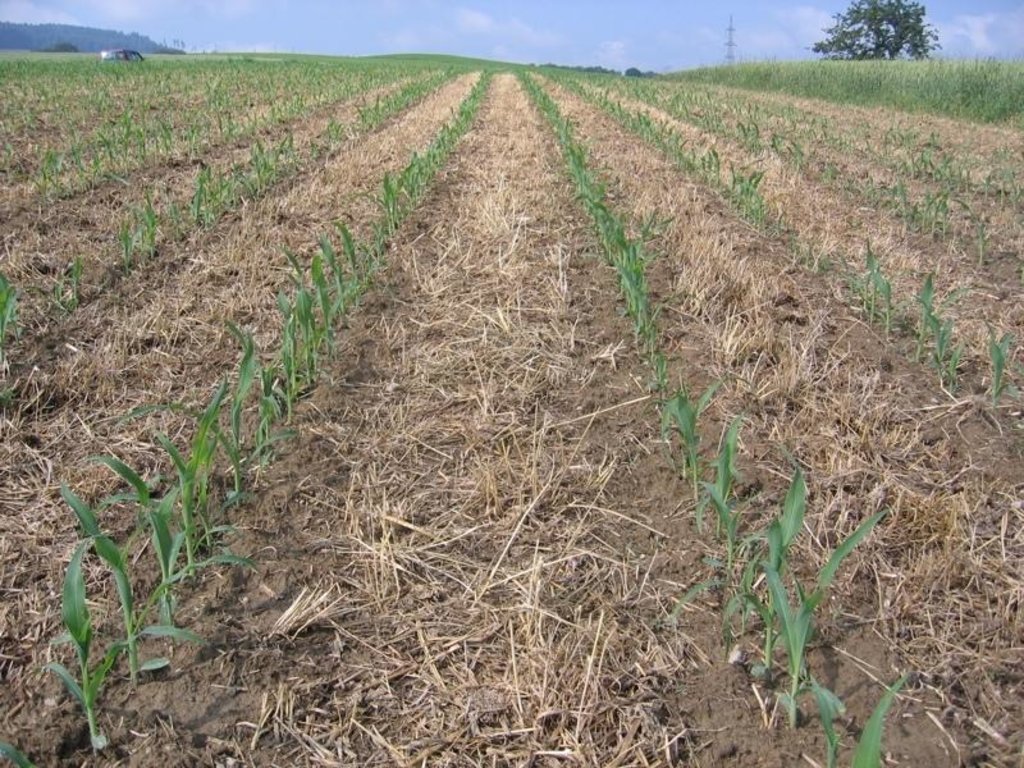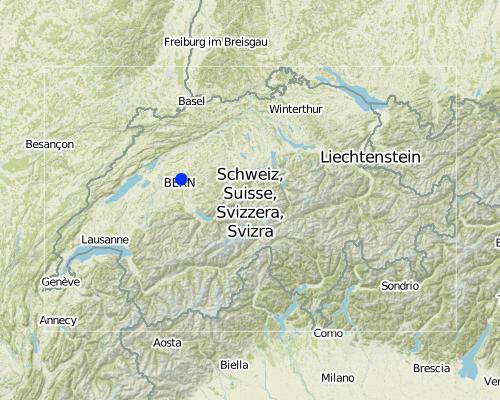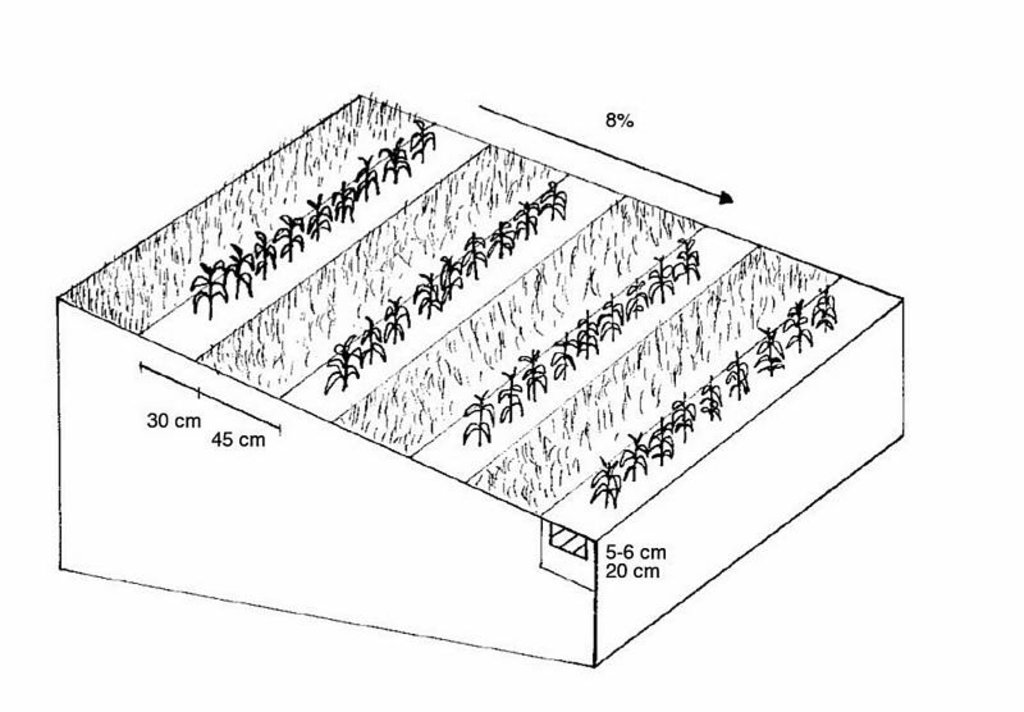Maize strip tillage [ប្រទេសស្វ៊ីស]
- ការបង្កើត៖
- បច្ចុប្បន្នភាព
- អ្នកចងក្រង៖ Nicole Guedel
- អ្នកកែសម្រួល៖ –
- អ្នកត្រួតពិនិត្យ Fabian Ottiger
Streifenfrässaat
technologies_1009 - ប្រទេសស្វ៊ីស
ពិនិត្យមើលគ្រប់ផ្នែក
ពង្រីកមើលទាំងអស់ បង្រួមទាំងអស់1. ព័ត៌មានទូទៅ
1.2 ព័ត៌មានលម្អិតពីបុគ្គលសំខាន់ៗ និងស្ថាប័នដែលចូលរួមក្នុងការវាយតម្លៃ និងចងក្រងឯកសារនៃបច្ចេកទេស
អ្នកប្រើប្រាស់ដី:
Schneider Markus
+41 (0)62 963 26 26
schneider.agrar-service@gmx.ch
Schneider Agrarservice
Obergasse 20, 4922 Thunstetten, Switzerland
ប្រទេសស្វ៊ីស
អ្នកប្រើប្រាស់ដី:
Bangerter Roland
+41 (0) 32 384 50 35
rol.bangerter@bluewin.ch
Gisleren, 3266 Wiler bei Seedorf, Switzerland
ប្រទេសស្វ៊ីស
ឈ្មោះអង្គភាពមួយ (ច្រើន) ដែលបានចងក្រងឯកសារ/ វាយតម្លៃបច្ចេកទេស (បើទាក់ទង)
CDE Centre for Development and Environment (CDE Centre for Development and Environment) - ប្រទេសស្វ៊ីសឈ្មោះអង្គភាពមួយ (ច្រើន) ដែលបានចងក្រងឯកសារ/ វាយតម្លៃបច្ចេកទេស (បើទាក់ទង)
Bangerter-Gisleren - ប្រទេសស្វ៊ីសឈ្មោះអង្គភាពមួយ (ច្រើន) ដែលបានចងក្រងឯកសារ/ វាយតម្លៃបច្ចេកទេស (បើទាក់ទង)
Schneider Agrar-service - ប្រទេសស្វ៊ីស1.3 លក្ខខណ្ឌទាក់ទងទៅនឹងការប្រើប្រាស់ទិន្នន័យដែលបានចងក្រងតាមរយៈ វ៉ូខេត
តើពេលណាដែលទិន្នន័យបានចងក្រង (នៅទីវាល)?
30/10/2008
អ្នកចងក្រង និង(បុគ្គលសំខាន់ៗ)យល់ព្រមទទួលយកនូវលក្ខខណ្ឌនានាទាក់ទងទៅនឹងការប្រើប្រាស់ទិន្នន័យដែលបានចងក្រងតាមរយៈវ៉ូខេត:
បាទ/ចា៎
2. ការពណ៌នាពីបច្ចេកទេស SLM
2.1 ការពណ៌នាដោយសង្ខេបពីបច្ចេកទេស
និយមន័យបច្ចេកទេស:
Maize strip tillage is a technology used for corn cultivation. It cultivates only thoses stripes in which the seed is added to.
2.2 ការពណ៌នាលម្អិតពីបច្ចេកទេស
ការពណ៌នា:
Maize strip tillage is a soil-conservation method used in crop production. First of all the grass in the area needs to be prepared by splattering round-up some 3-10 days prior seeding. Then the actual maize strip tillage machine carves a stripe and the seed are inserted within this 30 cm strip. At the same time fertilizer is added on these cultivated stripes. Between those cultivated stripes the mulch-grass stripes (45cm) are unmechanised and protect the soil by increasing its stability. The work is done within one working unit compared to the traditional technique whereas the farmer needs to drive for each working step separately.
There are some clear ecological advantages using this technology. Like in a minimum tillage system the stability of the soil is enhanced.
Due to these mulch-stripes the matrix of the soil is more complex and therefore the stability is better especially during harvest in September. The interviewed farmer said compaction would occur less and the risk of soil erosion is decreasing. Especially in hilly areas the technology is suitable since soil erosion is a problems when using a plough. Another advantage is the better soil structure due to the mulch stripes and the minimal tillage ensures that the soil is more stable.
A high level of knowledge about the natural environment is a required when adopting this technology. On one hand, the farmer must time the date for seeding adequately to the natural conditions (not too humid). On the other hand, the farmer has to apply Glyphosphat one to three times after the seeding in order to guarantee an optimal growth period for the corn.The interviewed farmer found it problematic to use this amount of Glyphosat and he was not sure about the effects in the water. The timing to start seeding with this technology may be later cause corn is sensitive towards rival plants, low temperatures and humidity. When adopting the technology the farmer needs to have a certain level of knowledge and experience in order to guarantee a sound harvest.
This technology is applied in the village Seedorf (Canton Bern) after the farmers made positive experiences and if they see the economic advantages too. Generally there is only one work step needed for the seeding which lowers the costs compared to the traditional technology with about a third. Furthermore the subsidies of the canton of Berne enables farmers to apply this technology for the first 5 years. In this cycle the areas are usually left with grass first, second cultivated with corn (using maize strip tillage), then sugar beets and after all two years of cereals (wheat and rye) before the cycle starts again.
2.3 រូបភាពនៃបច្ចេកទេស
2.5 ប្រទេស/តំបន់/ទីតាំងកន្លែង ដែលបច្ចេកទេសត្រូវបានអនុវត្ត និងបានគ្រប់ដណ្តប់ដោយការវាយតម្លៃនេះ
ប្រទេស:
ប្រទេសស្វ៊ីស
តំបន់/រដ្ឋ/ខេត្ត:
Seedorf
បញ្ជាក់បន្ថែមពីលក្ខណៈនៃទីតាំង:
Bern
មតិយោបល់:
27.2 km2 are owned by the farmer whereas he is applying the technology on 5 km2. He said that he is hired as a contract worker and applies the technology on approximately 90 km2
Map
×2.7 ការណែនាំពីបច្ចេកទេស
មតិយោបល់ (ប្រភេទនៃគម្រោង ។ល។):
A neighbouring farmer adapted the technology and after the first successful harvest Roland Bangerter bought a machine too some 5 years ago and started apply this technology.
3. ចំណាត់ថ្នាក់នៃបច្ចេកទេស SLM
3.2 ប្រភេទដីប្រើប្រាស់មួយប្រភេទ (ច្រើនប្រភេទ) ដែលបានអនុវត្តបច្ចេកទេស

ដីដាំដំណាំ
- ដំណាំប្រចាំឆ្នាំ
មតិយោបល់:
Major land use problems (compiler’s opinion): soil erosion in hillside areas
Major land use problems (land users’ perception): soil degradation in general
3.4 ក្រុម SLM ដែលបច្ចេកទេសស្ថិតនៅក្នុង
- កាត់បន្ថយការរំខានដល់ដី
- វិធានការអនុវត្តកាត់ទទឹងទីជម្រាល
3.5 ការសាយភាយនៃបច្ចេកទេស
មតិយោបល់:
Total area covered by the SLM Technology is 90 m2.
27.2 km2 are owned by the farmer whereas he is applying the technology on 5 km2. He said that he is hired as a contract worker and applies the technology on approximately 90 km2
3.6 វិធានការ SLM ដែលបញ្ចូលនូវបច្ចេកទេស

វិធានការក្សេត្រសាស្ត្រ
- A1: ដំណាំ/គម្របដី
មតិយោបល់:
Main measures: agronomic measures
Type of agronomic measures: cover cropping, retaining more vegetation cover, mulching, manure / compost / residues, rotations / fallows, minimum tillage
3.7 កំណត់ប្រភេទនៃការធ្លាក់ចុះគុណភាពដីសំខាន់ៗដែលបច្ចេកទេសនេះបានដោះស្រាយ

ការហូរច្រោះដីដោយសារទឹក
- Wt: ការបាត់ដីស្រទាប់លើដោយការហូរច្រោះ
- Wg: ការកកើតឡើងនូវកំទេចកំទីដីស្រទាប់ក្រោម

ការបាត់បង់រូបសាស្ត្រនៃដី
- Pc: ការហាប់ណែន

ការធ្លាក់ចុះជីវសាស្ត្រនៃដី
- Bc: ការថយចុះនូវគម្របរុក្ខជាតិ
មតិយោបល់:
Main type of degradation addressed: Wt: loss of topsoil / surface erosion, Pc: compaction
Secondary types of degradation addressed: Wg: gully erosion / gullying, Bc: reduction of vegetation cover
Main causes of degradation: crop management (annual, perennial, tree/shrub) (the use of plough increases the danger of soil erosion)
3.8 ការពារ កាត់បន្ថយ ឬស្តារឡើងវិញនៃការធ្លាក់ចុះគុណភាពដី
បញ្ជាក់ពីគោលដៅរបស់បច្ចេកទេស ដែលផ្តោតទៅការធ្លាក់ចុះគុណភាពដី:
- ការការពារការធ្លាក់ចុះគុណភាពដី
- ការកាត់បន្ថយការធ្លាក់ចុះគុណភាពដី
មតិយោបល់:
Main goals: mitigation / reduction of land degradation
Secondary goals: prevention of land degradation
4. បច្ចេកទេសជាក់លាក់ សកម្មភាពអនុវត្ត ធាតុចូល និងថ្លៃដើម
4.1 គំនូសបច្ចេកទេសនៃបច្ចេកទេសនេះ
4.2 លក្ខណៈពិសេសនៃបច្ចេកទេស/ ពណ៌នាពីគំនូរបច្ចេកទេស
Technical knowledge required for field staff / advisors: high
Technical knowledge required for land users: low
Main technical functions: improvement of topsoil structure (compaction), increase of infiltration
Secondary technical functions: improvement of ground cover, increase in organic matter
Manure / compost / residues
Material/ species: mulch stripes
Rotations / fallows
Remarks: a cultivation cycle of 5 year is needed
4.4 សកម្មភាពបង្កើត
| សកម្មភាព | ប្រភេទវិធានការ | ពេលវេលា | |
|---|---|---|---|
| 1. | Buying a 120 PS tractor | ក្សេត្រសាស្ត្រ | |
| 2. | Buying a machine for maize strip tillage | ក្សេត្រសាស្ត្រ | |
| 3. | buying a sowing machine | ក្សេត្រសាស្ត្រ |
4.5 ថ្លៃដើម និងធាតុចូលដែលត្រូវការសម្រាប់ការបង្កើតបច្ចេកទេស
| បញ្ជាក់ពីធាតុចូល | ឯកតា | បរិមាណ | ថ្លៃដើមក្នុងមួយឯកតា | ថ្លៃធាតុចូលសរុប | % នៃថ្លៃដើមដែលចំណាយដោយអ្នកប្រើប្រាស់ដី | |
|---|---|---|---|---|---|---|
| សម្ភារៈ | 120 PS tractor | Farm | 1,0 | 126000,0 | 126000,0 | 100,0 |
| សម្ភារៈ | Machine for maize strip tillage | Farm | 1,0 | 165000,0 | 165000,0 | 100,0 |
| សម្ភារៈ | Sowing machine | Farm | 1,0 | 12600,0 | 12600,0 | 100,0 |
| ថ្លៃដើមសរុបក្នុងការបង្កើតបច្ចេកទេស | 303600,0 | |||||
4.6 សកម្មភាពថែទាំ
| សកម្មភាព | ប្រភេទវិធានការ | ពេលវេលា/ ភាពញឹកញាប់ | |
|---|---|---|---|
| 1. | Adding some round-up on the field one week before technology is applied | ក្សេត្រសាស្ត្រ | 1 |
| 2. | Applying technology maize strip tillage | ក្សេត្រសាស្ត្រ | 1 |
| 3. | Adding herbicide on the mulch stripes | ក្សេត្រសាស្ត្រ | 1-3 |
| 4. | Harvest of corn | ក្សេត្រសាស្ត្រ | 1 |
6. ផលប៉ះពាល់ និងការសន្និដ្ឋាន
6.7 ភាពខ្លាំង/ គុណសម្បត្តិ/ ឱកាសនៃបច្ចេកទេស
| ភាពខ្លាំង/ គុណសម្បត្តិ/ ឱកាស ទស្សនៈរបស់បុគ្គលសំខាន់ៗ |
|---|
|
Prevention of erosion How can they be sustained / enhanced? Maintain green cover. |
|
Improvement of soil quality (fertility, organic matter, moisture retention, soil structure) How can they be sustained / enhanced? Ensure that cover vegetation doesn’t compete with the vines; improve soil properties by applying mentioned agronomic measures. |
|
Contribution to a better balanced and more stable ecosystem (with living space for a wider range of organisms) How can they be sustained / enhanced? Specific management of cover crops (alternating treatment of inter-rows; find solutions to replace application of herbicide). |
| In the long-term economically beneficial because of cutting costs of restoration of soils and fertility loss after heavy erosion events. |
| Possibilities of farm income increase through marketing wine under the ‘vinatura’ label, certifying ecologically produced wine. |
6.8 ភាពខ្សោយ/ គុណវិបត្តិ/ ហានិភ័យនៃបច្ចេកទេស និងវិធីសាស្ត្រដោះស្រាយ
| ភាពខ្សោយ/ គុណវិបត្តិ/ ហានិភ័យ ទស្សនៈរបស់អ្នកចងក្រងឬបុគ្គលសំខាន់ៗ | តើបច្ចេកទេសទាំងនោះបានដោះស្រាយបញ្ហាដូចម្តេច? |
|---|---|
| General competition of water and nutrients depending on climate, soil depth and species of cover vegetation | Eliminate/reduce competitive effect of cover vegetation by cutting/mulching vegetation or ripping/ploughing soil. |
| Application of herbicides around vines because of undesirable vegetation in proximity of vine | Find alternative solutions, or minimise application of herbicides. |
7. ឯកសារយោង និងវេបសាយ
7.2 ឯកសារយោងដែលបានចេញផ្សាយ
ចំណងជើង អ្នកនិពន្ធ ឆ្នាំ ISBN:
Güdel N . Boden- und Wasserkonservierung in Schweizer Rebbergen. Ein Beispiel im Rahmen von WOCAT. Unpublisheddiploma thesis.. 2003.
មានប្រភពមកពីណា? ថ្លៃដើមប៉ុន្មាន?
Centre for Development and Environment (CDE), University of Berne
ការតភ្ជាប់ និងម៉ូឌុល
ពង្រីកមើលទាំងអស់ បង្រួមទាំងអស់ការតភ្ជាប់
គ្មានការតភ្ជាប់
ម៉ូឌុល
គ្មានម៉ូឌុល


